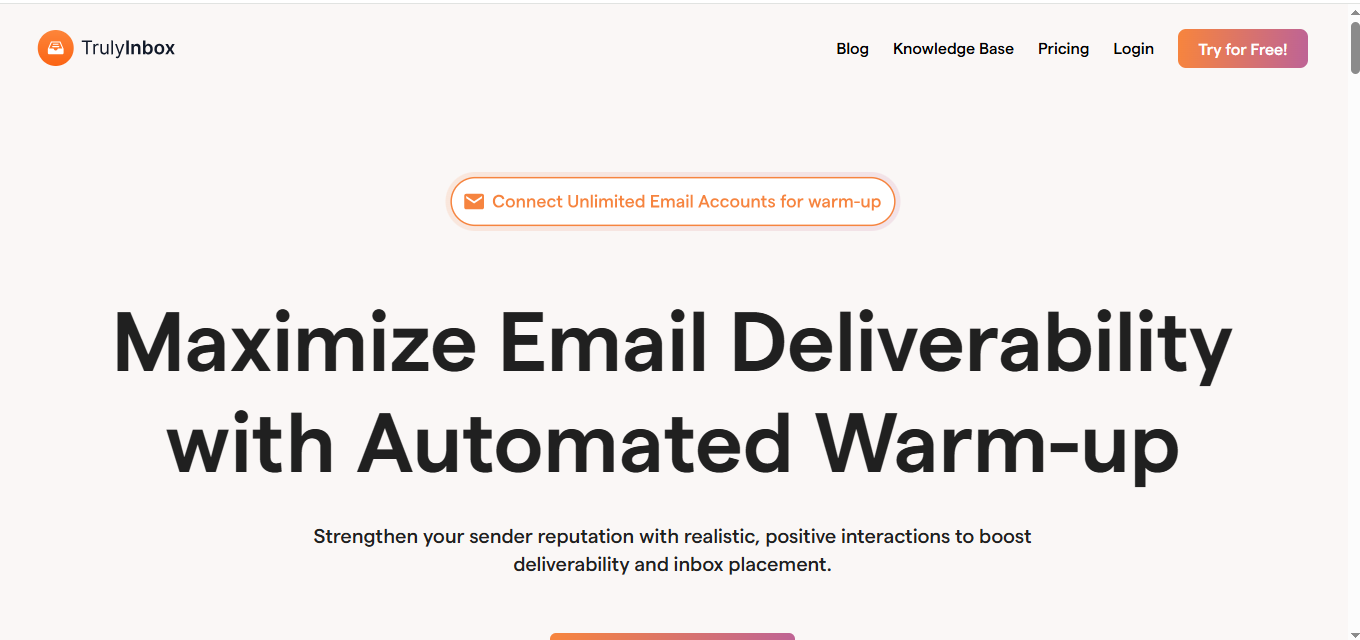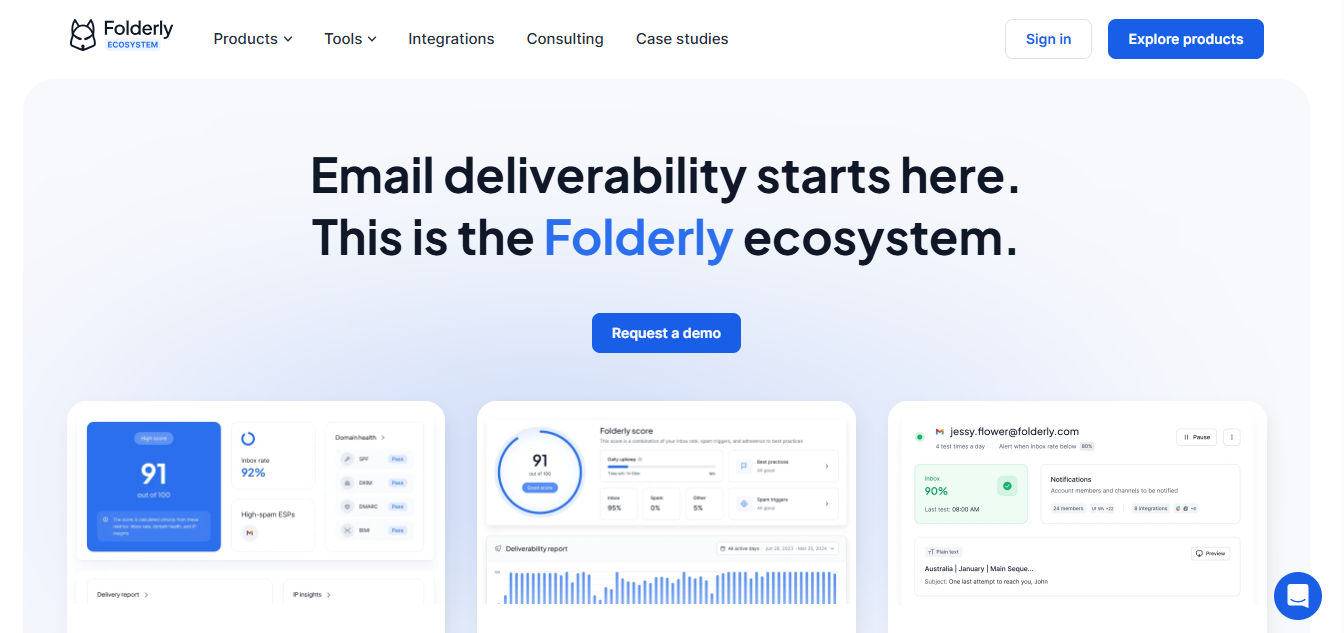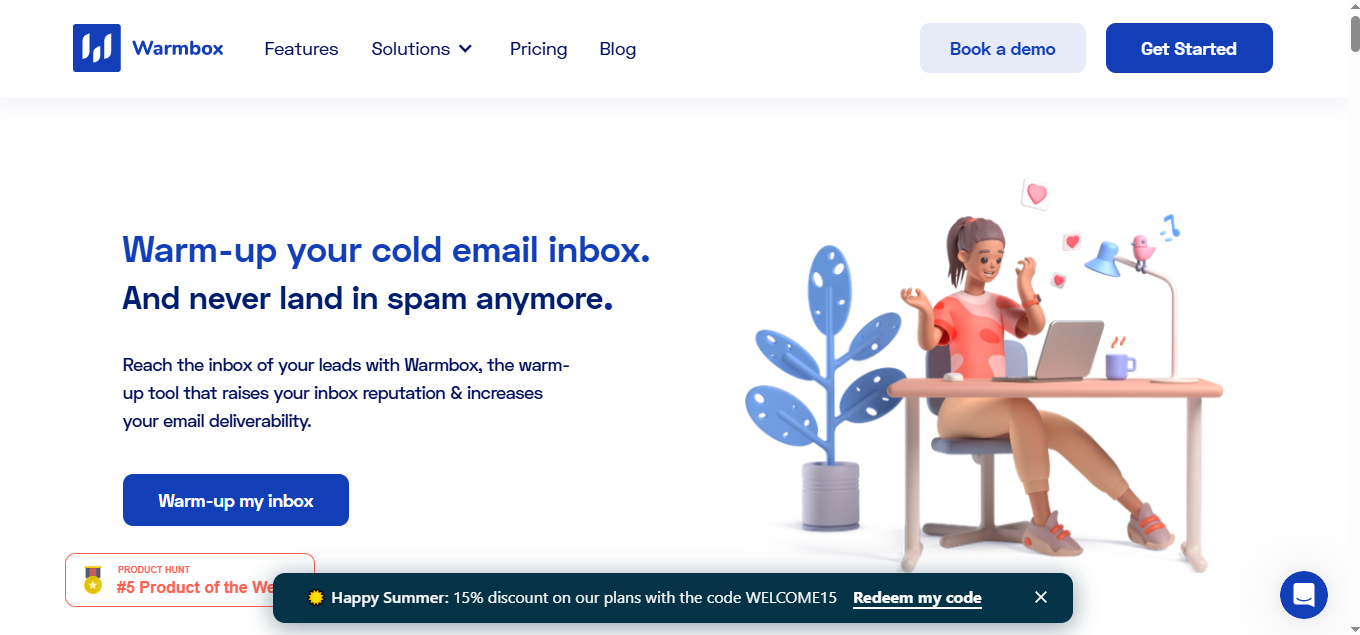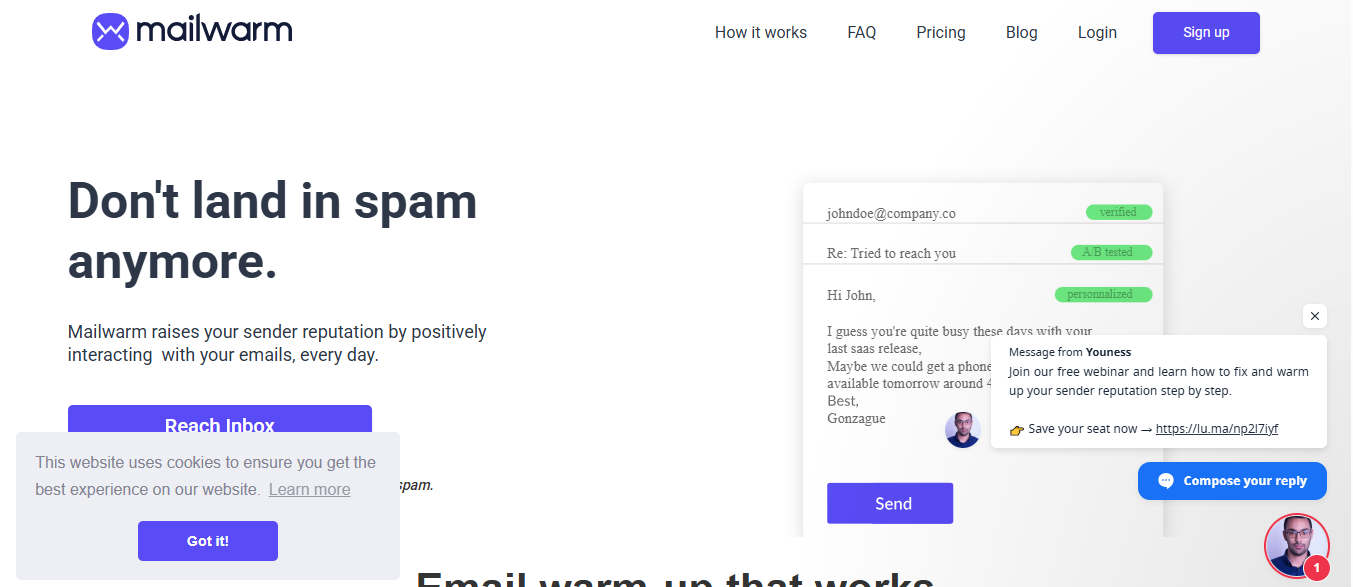We Tried 5 Automated Email Warmup Tools: Here's Our Verdict
If you’re looking at automated email warmup tools in 2025, you’re probably trying to improve deliverability and keep emails out of spam.
The problem is, not every tool actually works as promised, some warmups are slow, inconsistent, or fail to build a strong sending reputation.
That makes it tough for marketers, agencies, and founders to know which ones truly help and which ones are just hype.
To find out, we tried the 7 popular warmup tools - Warmforge, TrulyInbox, Lemwarm, Folderly, Mailwarm, Warmup Box, and Woodpecker.
We’ll look at inbox placement, sending reputation, speed, and overall effectiveness to see how they really perform.
By the end, you’ll know which tools genuinely improve deliverability, and which ones aren’t worth your time or money.
Here’s what we found:
Key Takeaways: Best Automated Email Warmup Tools Overall
- Best complete warmup and deliverability automation – Warmforge
- Best for realistic peer-to-peer warmup – TrulyInbox
- Best for personalized warmup with real inbox simulation – Lemwarm
- Best for warmup + domain monitoring – Folderly
- Best simple, scalable warmup for teams – Mailwarm
- Best for small teams and SMTP-based warmup – Warmup Box
- Best integrated warmup for outreach platforms – Woodpecker
Here’s How UniteSync Achieved an 85.26% Positive Reply Rate With Just $2.86 CAC
UniteSync used Salesforge, Mailforge, and Warmforge to land more emails in inboxes, boost reply rates, and scale cold outreach efficiently without hitting deliverability issues.
Read the full case study →
See the exact tools, strategy, and results.
What is Automated Email Warmup & How does it work?
Automated email warmup is the process of building trust for a new or inactive email account using a tool instead of doing it manually.
Rather than sending and replying to test emails yourself, these tools handle it automatically by sending, opening, replying, and even pulling messages out of spam to make your account look more trustworthy to email providers.
How We Evaluated These Automated Warmup Tools
To find the best Automated Email Warmup tools, we focused on a simple checklist that directly affects inbox placement and domain trust:
- Whether the tool fully automates sending, opening, and replying to emails without manual steps.
- How reliably it can recover emails from spam and promotions back into the inbox.
- If it simulates real human behavior, like opening, starring, and replying, in a natural way.
- Whether SPF, DKIM, and DMARC records are checked and aligned correctly.
- How well it scales across multiple inboxes and domains at the same time.
- If the reports are clear and easy to act on when deliverability issues appear.
This framework gave us a fair way to compare each tool and see which ones actually improve email deliverability in practice.
How Do These Automated Email Warmup Tools Compare
7 Best Automated Email Warmup Tools We Have Tried
Here’s a breakdown of the top automated email warmup tools, what makes them stand out, and how they can help you improve inbox placement, domain reputation, and reply rates.
1. Warmforge
Warmforge is a dedicated Automated Email Warmup platform built to do one thing exceptionally well:
Unlike general outreach platforms that tack on warmup as an extra feature, Warmforge focuses majorly on deliverability.

It works quietly in the background, simulating natural human interactions, patching authentication gaps, and steadily strengthening your sender reputation.
The result is simple: your emails avoid spam filters and consistently land in the inbox.
Warmforge Evaluation Across Key Factors
- Automation
Runs daily automated sending, opening, replying, and spam recovery cycles. - Setup time
Mailbox connection takes minutes; warmup starts instantly. - Warmup pacing
Increases volume gradually with natural patterns. - Spam recovery
Reliably pulls emails from spam and promotions. - Human-like behavior
Mimics real replies, opens, and timing variations. - Authentication checks
Monitors SPF, DKIM, and DMARC continuously. - Inbox placement
Strong inbox placement, steady reputation, consistent results. - Reporting
Shows inbox placement, reputation, and progress clearly. - Integrations
Operates standalone but works with major outreach tools. - Scalability
Handles multiple inboxes and domains without issues. - Support
Quick, helpful responses for setup and deliverability. - Reputation
Trusted by users as a dedicated warmup solution. - Security & privacy
Secures credentials and mailbox data against risks.
Pros (Real User’s Opinion)
- Quick to set up, most inboxes are ready in minutes.
- Clean and simple dashboard that anyone can navigate.

- Reliable warmup results with steady performance.
- The support team is fast and helpful when issues come up.
- Works smoothly with most cold email platforms.
Cons (Real User’s Opinion)
- Some advanced features need a bit of time to figure out.
- Initial setup can feel a little slow in certain cases.
Warmforge Pricing
- Email Warmup: $10 per mailbox slot (billed quarterly at $30 for 1 slot) – includes 1 free slot, automated AI warmup, 1 placement test/month, DNS & MX checks, and blacklist monitoring.
- Pro Placement Test Plan: $39/month ($32.5 if billed annually) – 100 tests/month, 50 mailboxes per test.
- Growth Placement Test Plan: $169/month ($140.8 if billed annually) – unlimited tests, 250 mailboxes per test, 2 months free on annual billing.
Verdict:
Warmforge keeps your inbox ready with reliable, automated email warmup that runs quietly in the background
If Automated Email Warmup is your priority and you want a tool that runs reliably without constant oversight, Warmforge is the safest and strongest choice.
Claim your 1 free warming slot + a free inbox placement test with Warmforge to see exactly where your emails land.
2. TrulyInbox
TrulyInbox takes a different approach to Automated Email Warmup, focused on realistic email behavior using a peer-to-peer network.
It sends and receives emails across multiple inboxes, interacts naturally with others, which helps build credibility for new domains quickly.

It’s especially popular among agencies that need to warm up multiple accounts at once without hitting platform limits.
TrulyInbox Evaluation Across Key Factors
- Automation
Automates sending and receiving emails through a peer-to-peer network. - Setup time
Simple onboarding; inboxes can be connected in minutes. - Warmup pacing
Gradually ramps up email activity but offers limited control. - Spam recovery
Moves some emails out of spam, though results vary with network activity. - Human-like behavior
Uses real accounts to create natural interactions between inboxes. - Authentication checks
Does not actively monitor SPF, DKIM, or DMARC. - Inbox placement
Placement unstable, reputation uneven at scale. - Reporting
Provides basic warmup activity logs and placement updates. - Integrations
Runs independently without deep integrations into outreach platforms. - Scalability
Supports multiple inboxes, but performance depends on network size. - Support
Standard support is available, but response times may vary. - Reputation
Known as a peer-to-peer warmup tool with agency adoption. - Security & privacy
Requires mailbox access; data handling practices are not deeply transparent.
Pros (Real User’s Opinion)
- Unlimited inbox connections, highly scalable.
- A peer-to-peer system makes activity look natural.
- Good for agencies managing many accounts.
Cons (Real User’s Opinion)
- Reporting is not as advanced as other tools.
- Limited service does not work well with providers like Google and Outlook.

- Lacks built-in DNS alignment checks.
- Setup can feel more technical for new users.
TrulyInbox Pricing
- Free Plan: $0/month – includes 1 inbox, up to 10 emails per day.
- Starter Plan: $22/month – with unlimited inboxes, up to 100 emails per day.
- Growth Plan: $59/month – offers higher email volume with additional features.
- Scale Plan: $142/month – built for large teams with advanced functionality.
- Business Plan: $217/month – includes premium support and maximum capacity.
Verdict:
TrulyInbox is a solid option if your priority is warming up multiple inboxes at scale.
Its peer-to-peer automation is effective, but the tradeoff is less advanced reporting and DNS oversight compared to specialized tools.
3. Lemwarm
Lemwarm is a Lemlist-integrated warmup tool that automates email engagement, including opens and replies, while monitoring inbox placement and email blacklist status.

This makes it a good fit for sales teams that want their domains to build trust without looking automated.
Lemwarm Evaluation Across Key Factors
- Automation
Automates sending, opening, and reply simulation within the Lemlist ecosystem. - Setup time
Quick to activate if you already use Lemlist; no separate setup needed. - Warmup pacing
Automatically adjusts sending volume but lacks custom pacing controls. - Spam recovery
Recovers some emails from spam though effectiveness depends on usage scale. - Human-like behavior
Simulates opens and replies designed to look natural for small to mid-size senders. - Authentication checks
Does not provide built-in SPF, DKIM, or DMARC monitoring. - Inbox placement
Realistic placement, slower reputation growth. - Reporting
Basic inbox placement tracking tied into the Lemlist dashboard. - Integrations
Restricted to Lemlist; not available as a standalone tool. - Scalability
Best suited for solo users or small teams; not ideal for managing many domains. - Support
Support available through Lemlist’s standard channels. - Reputation
Well-recognized among Lemlist users as an add-on feature. - Security & privacy
Operates within Lemlist’s security environment; no external risk exposure.
Pros (Real User’s Opinion)
- Super easy to use if you’re already in the Lemlist platform.
- Fully automated warm-up with realistic reply simulation.
- Keeps track of blacklist status and inbox placement.
- Smooth experience for solo users and smaller teams.
- Integrates nicely with Lemlist campaigns for a seamless workflow.
Cons (Real User’s Opinion)
- Only works inside Lemlist, not as a standalone tool.
- Advanced settings are locked behind higher-tier plans.
- No support for SMTP or external email services.
- Doesn’t manage DNS setup like SPF or DKIM.
- Not ideal if you need to scale across multiple domains or inboxes
Lemwarm Pricing
- Essential Plan ($24/month, billed yearly): Covers the basics with warm-up, reporting, and access to a 20K inbox network.
- Smart Plan ($40/month, billed yearly): Adds more advanced features like personalized warm-up emails and real-template warmup.
- Custom Plan (quote-based): For teams running 10+ inboxes, pricing is tailored to your setup.
Verdict:
Lemwarm is a strong choice for sales teams or smaller businesses that want a human-like automated warm-up. It delivers realistic interactions but may not be the most cost-effective option for larger operations.
4. Folderly
Folderly combines automated warmup with domain health checks and inbox monitoring to keep deliverability on track.
It checks SPF, DKIM, and DMARC alignment, monitors blacklists, and provides actionable insights to recover emails from spam folders.

Folderly is ideal for users who want a warm-up combined with infrastructure and email deliverability repair.
Folderly Evaluation Across Key Factors
- Automation
Automates warmup alongside deliverability diagnostics and fixes. - Setup time
Requires more configuration compared to basic warmup tools. - Warmup pacing
Increases sending activity steadily but at higher volumes. - Spam recovery
Actively rescues emails from spam and flags issues impacting placement. - Human-like behavior
Simulates inbox interactions but focuses more on technical health. - Authentication checks
Validates SPF, DKIM, and DMARC with detailed reporting. - Inbox placement
Good at fixing placement, restores domain health. - Reporting
In-depth dashboards highlight inbox placement, domain health, and blacklists. - Integrations
Operates independently; not tied to a specific outreach platform. - Scalability
Handles multiple inboxes, but becomes costly for larger teams. - Support
Specialized support for deliverability troubleshooting and audits. - Reputation
Known as an enterprise-level tool for diagnosing deliverability problems. - Security & privacy
Requires domain access for audits, which may raise privacy concerns.
Pros (Real User’s Opinion)
- Easy to set up, even if you’re not technical.
- Provides clear inbox placement reports.
- Boosts inbox placement and open rates noticeably.

- Offers strategic support with solid deliverability guidance.
- Simple interface with insights you can actually use.
Cons (Real User’s Opinion)
- Sends high warm-up volume without much user control.
- The algorithm can sometimes misfire and block real emails.

- No option to manually pace warm-up cycles.
- Risk of bounces that could impact the domain reputation.
- Pricing is on the higher side compared to competitors.
- Doesn’t test spam placement for image-heavy emails.
- Privacy concerns were raised during audit processes.
Folderly Pricing
- 1–9 Mailboxes: $120/month per mailbox – includes automated warmup, reputation monitoring, and spam recovery.
- 10–24 Mailboxes: $90/month per mailbox – same features with scaled pricing.
- 25–99 Mailboxes: $70/month per mailbox – best value for larger teams.
- 100+ Mailboxes: Custom quote – tailored pricing for enterprise needs.
- Annual plans offer up to 20% savings.
Verdict:
Folderly is ideal if you need both automated warmup and deep deliverability repair. It’s more than just a warmup tool, making it a good choice for businesses facing technical barriers, though it comes at a higher cost.
5. Warmbox.ai
Warmbox.ai is built to handle automated email warmup for you, so you don’t have to manage it manually.
Instead of just sending a few emails back and forth, it uses a large private network of real accounts combined with AI to make your warm-up look authentic.

The tool adapts how it interacts based on your chosen strategy, which makes it stand out for users who want more control over how fast their email reputation improves.
Warmupbox Evaluation Across Key Factors
- Automation
Automates sending, opening, and reply simulation through SMTP connections. - Setup time
Quick setup with mailbox connection; minimal configuration needed. - Warmup pacing
Increases activity gradually but lacks advanced pacing controls. - Spam recovery
Recovers emails from spam with moderate consistency. - Human-like behavior
Generates realistic engagement patterns across connected inboxes. - Authentication checks
Does not actively monitor SPF, DKIM, or DMARC. - Inbox placement
Steady placement, basic reputation support. - Reporting
Provides clear daily warmup reports with progress tracking. - Integrations
Works independently; connects through SMTP, not native outreach platforms. - Scalability
Supports multiple inboxes but is designed mainly for small teams. - Support
Basic support available; response times may vary. - Reputation
Positioned as a straightforward warm-up tool for simple setups. - Security & privacy
Mailbox data routed via SMTP; standard security measures applied.
Pros (Real User’s Opinion)
- AI-driven warmup that feels realistic.
- Let's you choose different pacing strategies (slow, balanced, or aggressive).
- Good reporting for monitoring progress.
Cons
- No built-in DNS record fixing.
- Pricing is on the higher side compared to simpler tools.
Warmbox Pricing
- Solo Plan: $15/month – 1 inbox, up to 50 emails per day, premium support included.
- Startup Plan: $69/month – 3 inboxes, up to 250 emails per day, with premium support.
- Growth Plan: $139/month – 6 inboxes, up to 500 emails per day, with enterprise support.
- Team Plan: Custom pricing – tailored features and support for larger teams.
Verdict:
Warmbox.ai is best for teams or agencies that want more than just basic automation. If you need data-driven insights and flexible strategies, this tool earns a spot at the top of your list.
6. Mailwarm
Mailwarm takes a more straightforward approach to Automated Email Warmup that simulates natural email engagement, including opens and replies, while monitoring inbox placement and blacklists.

With a simple interface and SMTP integration, it’s tailored for small teams and solo users seeking reliable warmup without complex setups or manual tracking.
Mailwarm Evaluation Across Key Factors
- Automation
Automates daily sending, opening, and reply actions to improve reputation. - Setup time
Simple onboarding; mailboxes connect within minutes. - Warmup pacing
Fixed pacing schedules with limited customization. - Spam recovery
Moves emails out of spam folders, though results can vary. - Human-like behavior
Simulates opens and replies across a warmup network to mimic natural activity. - Authentication checks
Does not monitor SPF, DKIM, or DMARC alignment. - Inbox placement
Consistent placement, reputation slows down with high volume. - Reporting
Provides straightforward dashboards with daily activity and reputation trends. - Integrations
Operates as a standalone tool without native outreach integrations. - Scalability
Handles multiple inboxes but is best suited for small to mid-sized teams. - Support
Offers standard customer support; speed may differ by plan. - Reputation
Recognized as a reliable entry-level tool for automated warmup. - Security & privacy
Requires mailbox access; follows standard email security practices.
Pros (Real User’s Opinion)
- Quick and easy setup with SMTP integration.
- Simulates real opens and replies for natural engagement.
- Clear daily warm-up reports to track progress.
- Monitors blacklist status with timely alerts.
- Simple interface, great for small teams.
Cons (Real User’s Opinion)
- Doesn’t include DNS or domain management.
- Advanced analytics and customization are limited.
- Quality of reply simulation can sometimes vary.
- No integrations with outreach platforms.
- Support response times can be slow at times.
Mailwarm Pricing
- Starter Plan: $29/month – 100 emails per day, 2 blacklist monitors, unlimited inboxes.
- Professional Plan: $79/month – 600 emails per day, 10 blacklist monitors, unlimited inboxes.
- Business Plan: $199/month – 2,000 emails per day, 50 blacklist monitors, unlimited inboxes.
- Free Trial: 7-day free trial available across all plans.
Verdict:
Mailwarm is perfect if you just want a warm-up done without any extra complexity. It’s reliable, simple, and cost-effective, exactly what smaller teams or solo senders need.
7. Woodpecker
Woodpecker is primarily a cold email outreach platform, but it comes with a built-in Automated Email Warmup feature.
This makes it convenient for users already managing campaigns inside Woodpecker since warm-up is handled alongside outreach.

It’s not as advanced as standalone tools, but it works well if you want an all-in-one solution.
Woodpecker Evaluation Across Key Factors
- Automation
Includes built-in warmup that sends, opens, and flags emails automatically. - Setup time
Fast activation for users already inside the Woodpecker platform. - Warmup pacing
Runs steady cycles but offers limited customization. - Spam recovery
Can pull some emails out of spam, though effectiveness is basic. - Human-like behavior
Simulates standard opens and replies, sufficient for light warmup needs. - Authentication checks
Does not provide DNS or domain-level authentication monitoring. - Inbox placement
Modest placement gains, limited reputation lift. - Reporting
Delivers simple warmup stats tied into outreach reporting. - Integrations
Integrated directly with Woodpecker campaigns; no external use. - Scalability
Works best for individual accounts; limited for high-volume setups. - Support
Support provided through Woodpecker’s existing channels. - Reputation
Recognized mainly by current Woodpecker users as a convenience feature. - Security & privacy
Operates within Woodpecker’s platform framework, limiting external risk.
Pros (Real User’s Opinion)
- Convenient if you already use Woodpecker for outreach.
- Easy to set up with warmup running in the background.
- Keeps costs lower by bundling warm-up with outreach.
Cons (Real User’s Opinion)
- Warmup features are basic compared to dedicated tools.
- No DNS or blacklist monitoring.
- Not scalable for agencies or high-volume users.
Woodpecker Pricing
- Cold Email Plan: $29 per month for each inbox slot – includes core cold email features plus automated warmup.
- Agency Plan: $49 per month for each slot – designed for teams and agencies with centralized control and larger outreach capacity.
- Enterprise Plan: Custom pricing – built for organizations needing advanced flexibility, volume, and support.
- Warmup Add-On: $5 per mailbox monthly – additional warmup capacity for users managing multiple inboxes.
Verdict:
Woodpecker is best for existing users who want a basic automated warm-up without switching tools.
It’s practical for light warmup needs but lacks the depth and scalability of dedicated solutions.
Other Key Factors You Shouldn’t Ignore
From our experience testing multiple automated email warmup tools, we noticed that the right features make all the difference.
Here’s our auto-warmup checklist, which helps you find the best tool.
- ✅ Consistency over time – The best tools kept our warmup running smoothly every day without gaps or sudden spikes.
- ✅ Customizable patterns – Being able to adjust send frequency, volume, and reply behavior made inbox placement much more natural.
- ✅ Safety checks – Tools with built-in safeguards helped us avoid bounces, spam hits, and blacklisting.
- ✅ Cross-inbox support – Managing multiple inboxes at once without extra setup saved us a lot of time.
- ✅ Insightful dashboards – Clear reports let us see progress and quickly fix any issues before they impact deliverability.
Use this checklist to keep your automated email warmup safe, effective, and scalable.
Conclusion:
After testing 7 automated email warmup tools across hundreds of inboxes, we found that the impact on deliverability is real but varies by tool.
Warmforge and TrulyInbox delivered the most realistic peer-to-peer warmups, while Lemwarm stood out for personalized inbox simulations.
Folderly offered the strongest domain monitoring features, but it came at a higher cost.
Tools like Mailwarm, Warmup Box, and Woodpecker are solid options for teams looking for simple, scalable solutions.
Overall, automated warmup isn’t a magic fix, but it can significantly improve inbox placement and boost sender reputation when paired with proper authentication, clean lists, and healthy sending habits.
If you want to see the difference, try Warmforge today - you’ll get 1 free warming slot plus a free inbox placement test to understand exactly how your emails perform.
FAQs
Q1. What is automated email warmup?
Automated email warmup is a system that gradually sends, receives, and interacts with your emails to build trust with email providers. It helps improve inbox placement and protects your domain reputation.
Q2. Why do I need an automated warm-up for cold outreach?
Cold email accounts that aren’t warmed up often land in spam. Automated warmup ensures your emails reach the inbox, increasing open rates and reply chances without manual effort.
Q3. How does Warmforge help with email deliverability?
Warmforge automates the warmup process, mimics real user interactions, monitors inbox placement, and ensures your domain stays healthy, helping your cold emails reach the inbox consistently.
Q4. Can automated warmup work for multiple inboxes?
Yes. Tools like Warmforge support warming multiple email accounts simultaneously, saving time and keeping all your inboxes healthy.
Q5. How long does it take to see results from automated warmup?
Typically, you can start seeing better inbox placement within 1–2 weeks, depending on the age of the email domain and sending volume.
Q6. Is Warmforge safe to use?
Absolutely. Warmforge has built-in safeguards to prevent bounces, spam hits, and blacklisting, keeping your email domains secure while warming them automatically.